Why Science Is Closer Than You Think To Beating Blindness
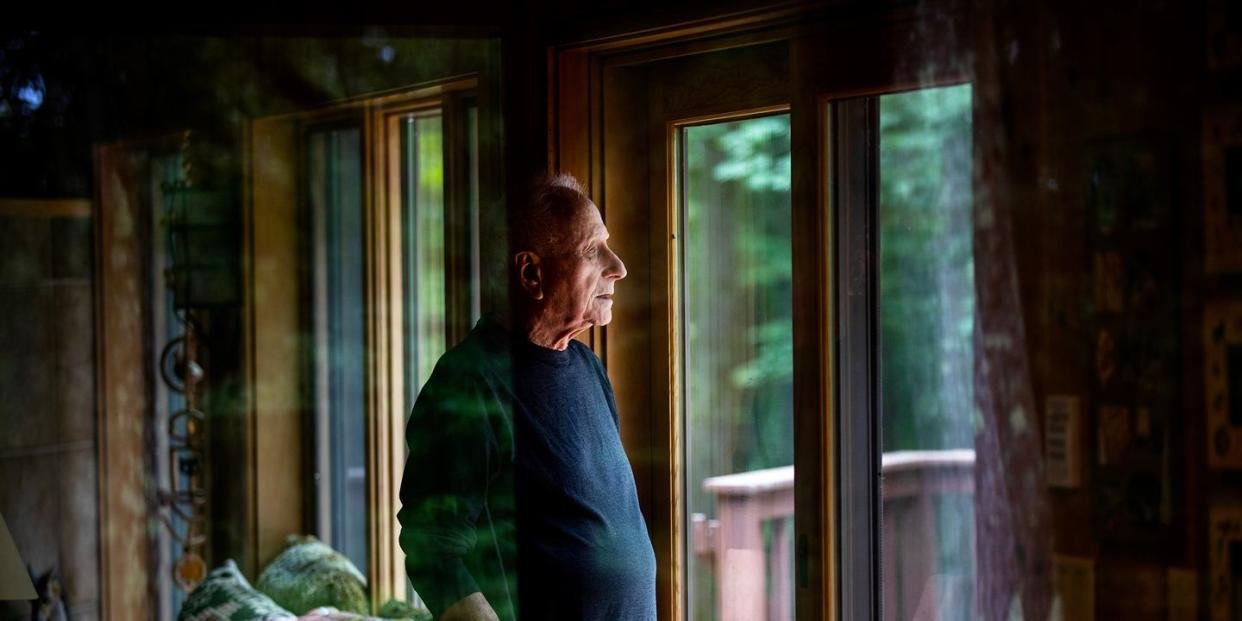
About 170,000 vehicles use New York City’s Queensboro Bridge each day, passing by Larry Misrok’s apartment building, which sits at the entrance to one of the ramps. Crossing the street there might be a daunting task for anyone, but for Misrok, an 83-year old lawyer, it could be deadly. He is virtually blind.
Fortunately, Misrok has help to navigate the city’s busy streets and broken sidewalks: a healthy pair of eyes with 20/20 vision located hundreds, maybe even thousands, of miles away. Using high-tech, camera-equipped eyeglasses, along with an app on his smartphone, Misrok is guided by a trained agent who can see in real time on his or her computer screen what Misrok cannot see before him. “Watch out, there’s a curb ahead,” the helper might say, or “There’s a cyclist coming up on your right.” It’s like having a friend at his side when the environment is too dangerous or too challenging to navigate with only a cane, the traditional way the vision-impaired navigate the world.
Obvious safety benefits aside, this innovative tool, called Aira, is also useful for assisting with grocery shopping, selecting cafeteria items, choosing clothing, operating office equipment, sorting mail, interpreting slide presentations, and other tasks that are difficult or impossible for people with low vision. A quick call puts Misrok in contact with one of hundreds of paid Aira agents located around the country who are standing by to commandeer the camera on his glasses and narrate his surroundings.
The Aira system is just one of dozens of groundbreaking adaptive technologies that help people who are blind or have low vision live more independently and actively. Many are readily available, like the VoiceOver feature on the iPhone, which tells you what buttons you’re pressing; or GPS apps that let you know where you’re standing in the middle of a city and can announce bus and train stops, and vibrate every time a street is crossed.
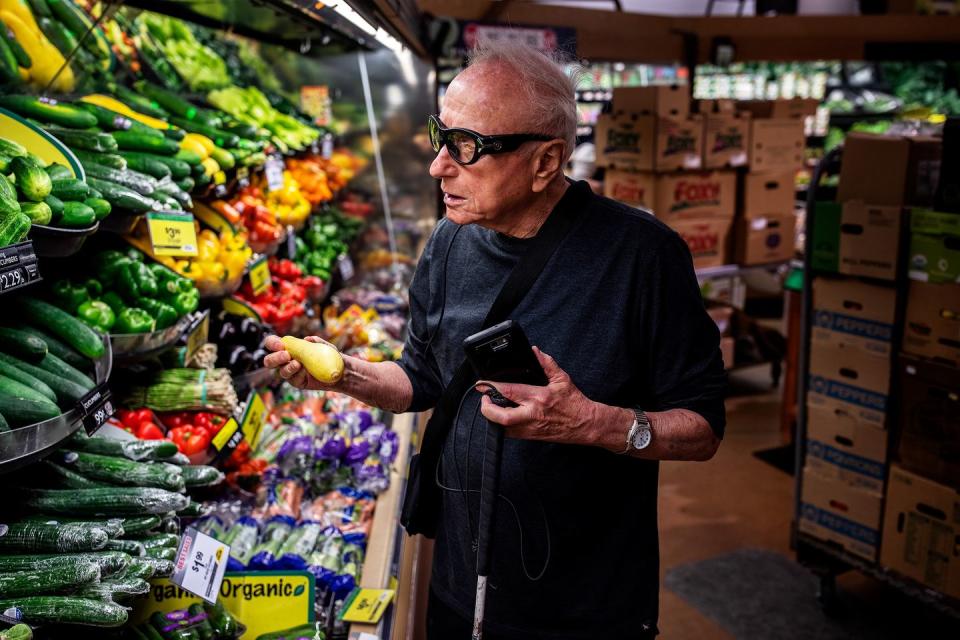
There’s a popular app called Be My Eyes that, like Aira, puts the user in touch with sighted volunteers who help them see prescription labels, thermostat temperatures, and how much money they’re holding in their hands. Richard Faubion, a development director for the Foundation Fighting Blindness, who is severely visually impaired himself, says he’ll call a Be My Eyes volunteer when he wants to know things like whether his tie matches his shirt, if he’s holding a can of peas or green beans, or if his suitcase is about to go by at an airport luggage carousel.
For computer work, there’s JAWS (Job Access With Speech) and NVDA (Nonvisual Desktop Access) software that reads aloud the text on a screen and tells the user what they are typing as they type. Seeing AI, developed by Microsoft, combines many tools into one app, using artificial intelligence to describe people, text, and objects.
“Technology can be an extremely powerful tool for someone who is visually impaired if it is used along with a person’s other skills and abilities,” says Ryan Jones, a legally blind project manager with Vispero, which helps companies become more accessible to people with disabilities. “These programs allow equal access to opportunities and careers for people who are visually impaired.”
VIDEO: How the Aira Glasses Work
About 1.3 million Americans 40 and older are legally blind. Another 2.9 million in the same age bracket have a vision impairment (defined as having sight worse than 20/40 in a person’s better eye after correction), according to the National Eye Institute. That’s 4.2 million people who have limited or no sight, a jump from 3.3 million in 2000. That figure is expected to grow to about 7.2 million by 2030 and 13 million by 2050. Fortunately, science and technology are alleviating many of the hardships associated with vision impairment—and have the potential to render some forms of blindness obsolete. But will they evolve fast enough for Larry Misrok and others like him?
Misrok’s troubles began in the 1970s, when he started seeing floaters. “I thought it was a result of getting my head banged with a basketball the year before,” he says. He went to a local eye doctor but was told his problem was beyond their expertise. He met with a stream of experts at Mount Sinai Hospital, NYU Langone Hospital, Johns Hopkins Hospital, and the National Institutes of Health in Bethesda, Maryland, and finally learned he had a rare disease that caused progressive inflammation in the vascular layer of his eyes, destroying his retinas. The condition is called birdshot chorioretinopathy, for the small light-colored spots appearing on the retina that resemble the scattered pattern of birdshot from a shotgun blast. “Right now, I can’t see you very well,” Misrok tells me as I sit just two feet away from him. “I know someone’s there, but I can’t tell if you’re smiling or frowning.”
Not without Aira, anyway. I visit him one Saturday afternoon to learn how the technology works. When we are ready to take a walk, Misrok puts on the glasses and headset with earphones, calls up the Aira app, and dials into an agent. Carl in Los Angeles picks up.
“I’m Larry Misrok,” he says. “We’re going to go for a walk out of my apartment. Is the visual working well? I know you have audio.”
“The visual seems to be working,” the agent replies.
With his cellphone in one hand and a white cane in the other, Larry walks down the hallway. By the time we reach the elevator, we’ve lost the connection and the agent is gone.
Aira users can access it free of charge at locations across the United States through a network of partners who sponsor the service for physical and digital interactions that make their customer experience completely accessible. Explorers can opt in to a subscription that runs from $29 for 30 minutes to $199 a month for 300 minutes. The glasses cost $600, or $25 a month.
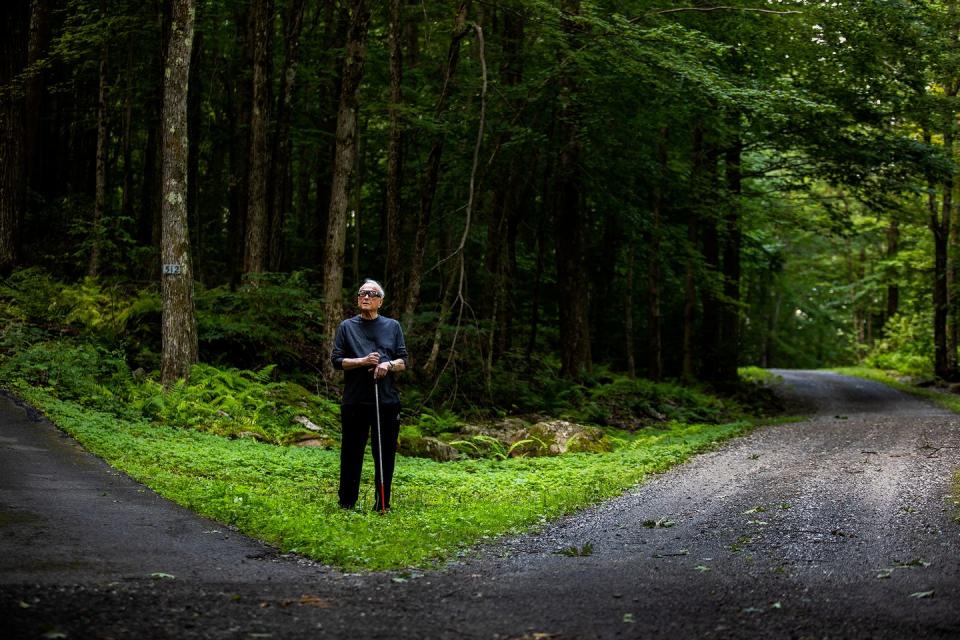
Misrok says he finds the glasses helpful in Massachusetts, where he has a home in the Berkshires. Although the connection there can be spotty, “I can walk alone, and they keep me on the road, not walking off into the bushes,” he says. “I don’t need them for going to work. I have a good staff.”
We walk outside of his apartment building to get a better connection. “These are some of the problems with technology, and some of the frustrations when you’re visually handicapped,” he says as he tries to reconnect the dropped call.
“Is this why you don’t want to rely on it?” I ask.
“I don’t want to rely on anything,” he says. “I want to rely on myself as much as possible.”
Alex Bindel avoids gadgets for the visually impaired altogether. He’s holding out for the technology that will give him all of his sight back. He’s been waiting a long time. Now 52, Bindel (not his real name—he requested anonymity out of concern that going public with his condition would affect his business) was diagnosed with retinitis pigmentosa (RP) at the age of 12. RP is a group of genetic disorders that cause night blindness and tunnel vision, and can sometimes lead to total blindness.
Bindel remembers the first time he felt the burden of impairment. One night when he was 12, he went to a bonfire with an older cousin who didn’t know about his condition. Unable to see little more than the fire, he accidentally sat down on top of someone, embarrassing his cousin, who yelled at him in front of the group. “To this day, it’s my biggest nightmare to be in a situation at night in the woods,” he says. Ultimately, his progressing disease compelled him to leave a computer consulting job in Los Angeles, sell everything he owned, buy a motorcycle, and travel across the country. “I feared I wouldn’t be able to see it all before I went blind,” he says. A few years later, he packed up again to see the world, traveling to 40 countries while working odd jobs. He milked cows in Norway, picked grapes in France, taught English in Italy. And he met a woman and moved with her to Namibia, where he lives today.
VIDEO: How the Be My Eyes app helps people with low vision navigate their world.
Bindel has now lost his peripheral vision and has an even harder time seeing at night. Like many with poor vision, he compensates by making mental notes of his surroundings like counting the number of steps in a staircase until he reaches the landing.
And yet, outside of enlarging the font on his computer, Bindel continues to spurn technology for the visually impaired. “I didn’t feel comfortable using it,” he says. “I never wanted people to know. I still don’t. I never wanted people to treat me differently.”
Instead, Bindel is waiting for a genetic cure to his disorder. And he may not have to wait much longer. Researchers are currently developing therapies to fix the broken genes that cause vision loss in the first place. One growing area of experimentation involves replacing the problematic gene with a copy of a functioning one. The farthest along is a gene therapy for people with vision loss from mutations in the gene RPE65 that lead to conditions like the RP that Bindel has and others. Nearly all patients with RPE65 mutations go blind. The therapy, called Luxturna, received FDA approval in 2017.
“Gene therapies for inherited retinal diseases have several outcomes: slowing or stopping the progression of disease, or restoring aspects of visual function that have been lost,” says Daniel Chung, D.O., clinical ophthalmic and medical strategy lead at Spark Therapeutics, the Philadelphia company that developed Luxturna. “With Luxturna, we’ve seen restoration of aspects of previously lost visual function, such as increased light sensitivity and overall improvement in functional vision.”
Other gene replacement therapies on the horizon include:
• A molecule designed to slow vision loss in RP patients by protecting retinal cells from oxidative stress. So far, studies show it can slow retinal degeneration in mice.
• A drug based on a modified version of vitamin A to address the genetic defect associated with Stargardt disease, a type of macular degeneration caused by the dysfunction of a protein that helps process the vitamin.
• Gene therapy products designed to address achromatopsia (ACHM), an inherited condition resulting from gene mutations that causes a number of symptoms including color blindness and extreme light sensitivity. Most people with ACHM are legally blind. Tests of the therapy on dogs and sheep have shown promise.
• A gene therapy to address choroideremia, a genetic mutation that leads to degeneration of the choroid (Misrok’s vision is affected by choroid damage). In clinical trials, more than 90 percent of participants reported improved visual acuity or at least no further degeneration a year later.
Gene replacement therapies are groundbreaking, but some scientists believe that gene editing (fixing the broken part of a gene) shows even more potential. “If I had to bet on where the big breakthroughs are going to be over the next (decade), I’d have to say its gene editing,” says Stephen Daiger, Ph.D., a professor of environmental and genetic sciences and ophthalmology at the University of Texas Health Science Center at Houston.
Clustered regularly interspaced short palindromic repeats, or CRISPR, for short, inserts a healthy piece of DNA into the damaged portion of a gene. “[CRISPR] is relatively inexpensive and conceptually easy to do,” Daiger says, adding that “we’re still at the very early stages of doing this with humans and working on the retina.”
Several research institutions are working on CRISPR projects aimed at RP disorders, including Johns Hopkins University in Baltimore, Columbia University in New York City, and Massachusetts Eye and Ear in Boston.
When I return to Misrok’s apartment a few weeks after our first meeting, I find him sitting at his kitchen table wearing his Aira glasses. He dials and is soon talking to Noah in Minnesota who describes everything in front of him as Misrok’s camera surveys the room.
I ask if I can try the glasses. I slip them on and, with my eyes open, listen to Noah describe what’s in my field of vision: The kidney-shaped coffee table to my right. The bookshelf to my left. The doorway to the kitchen in front of me. As I walk through the kitchen, Noah describes the refrigerator and countertops. I quickly see pitfalls. He fails to describe the rug under my foot, and I almost trip on it. And the directions are coming so fast—countertop colors, tabletop patterns—I imagine that if I couldn’t see, I would have trouble deciphering what’s relevant. Doing it outside on a Manhattan street, with all the cars, buses, traffic lights, people, strollers, and bicycles, would feel like an onslaught.
I give the glasses back to Misrok, and we make our way to Whole Foods, this time with the help of Ashley in Sacramento. The store is only half a block away, yet so many things could go wrong. At one point, we stand in the middle of a bike lane. We then have to cross Second Avenue and its six lanes of traffic. I’m relieved when we finally get to the store.
WHAT MAKES THE AIRA GLASSES SO SMART?
1.85 oz.
Camera located at center of bridge
120-degree field of view
5 MP resolution
8 hours of battery life w/continuous video streaming with agent
8 GB memory
512 MB RAM
4G LTE
802.11a/b/g/n/ac wi-Fi connectivity
v4.0 LE bluetooth
$124 per month for Horizon Kit (smart glasses, phone, charger) and 120 minutes of service
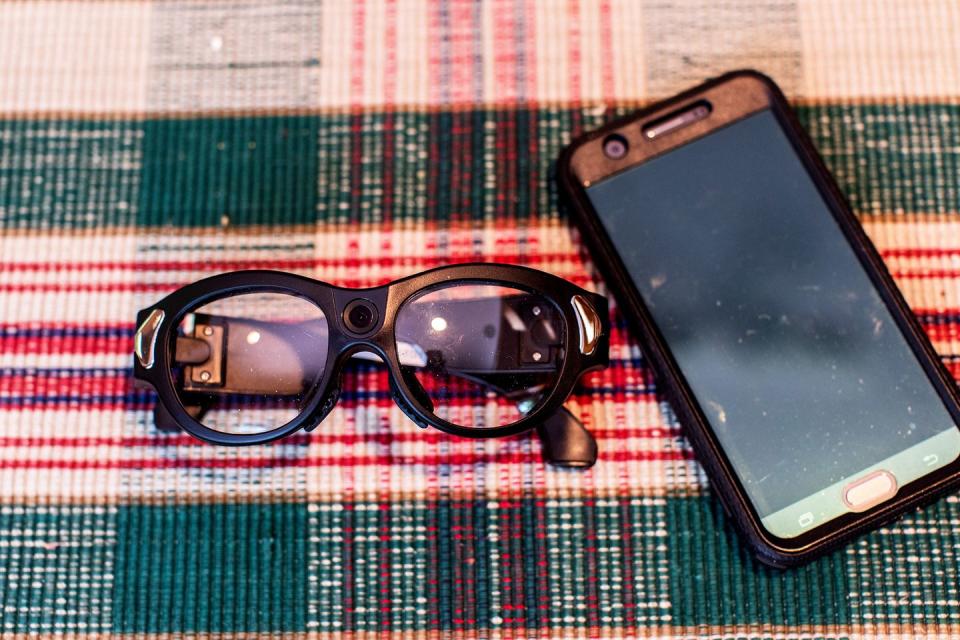
Back at Misrok’s apartment, I try out the glasses again—this time with my eyes closed. Despite the helper’s assistance, I quickly get tangled in a corner of the living room. Holding Misrok’s long cane, I tap the walls in the corner and bounce it between a shelf and a chair like a Pong cursor. Frustrated, I open my eyes to free myself from the corner and then close them again to move into the next room before taking the glasses off. “I cheated a couple of times,” I admit to Misrok. “I opened my eyes.”
Misrok laughs: “I wish I could cheat.”
A few months later, I meet Misrok at his law office on Long Island. He’s been experimenting with the Be My Eyes app when Aira’s connection isn’t working, like on a recent walk near his home in the Berkshires where the signal was too spotty to get Aira. Or like now, in his office. He calls up Be My Eyes and gets Jennie from Georgia. He holds the phone up to his law library and asks her if she can read the titles on the binders of the books. She says she can’t, that they’re too blurry. I then hold the camera closer to the books and at just the right angle—because I can see what that angle should be—and Jennie begins to reel off the titles.
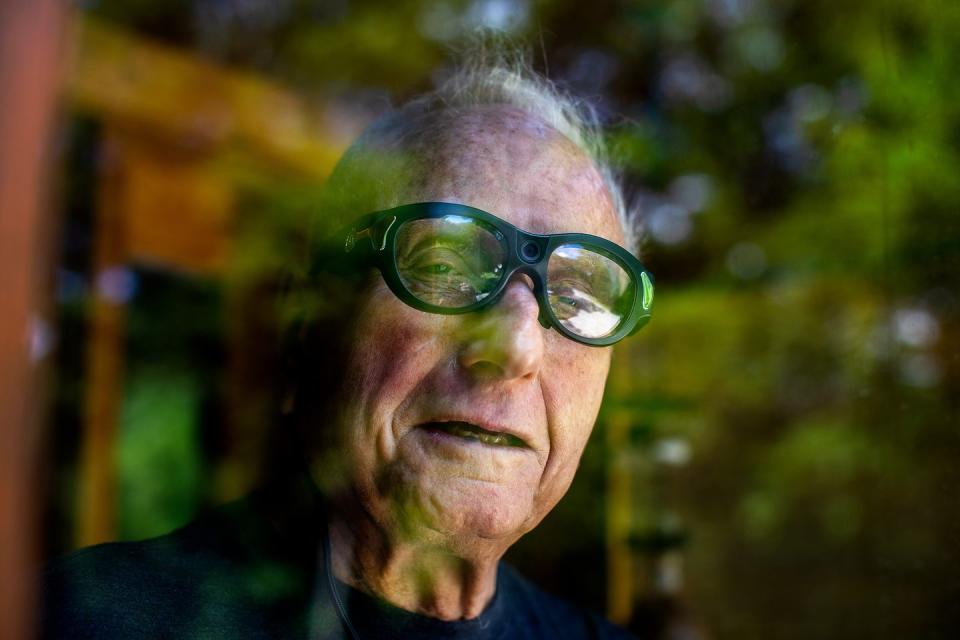
As I leave to catch a train, the secretaries in Misrok’s office have just brought back food for their lunch and are sitting down at the conference table to eat.
“Larry, we got you a salad,” says the assistant who has worked there the longest. Misrok walks into the conference room and uses the aids to which he’s most accustomed: the kindness of those who love him.
This article was originally published March 6, 2019. It’s been updated with new information and was published in the September 2019 issue of Popular Mechanics. You can subscribe here.
You Might Also Like

